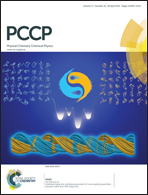A fluorescent receptor for halide recognition: clues for the design of anion chemosensors†
Abstract
The chemosensing properties of the polyaza-macrocycle 1-(6,7)-acridine-3,6,9,12-tetraaza-tridecaphane have been investigated by means of emission fluorescence spectroscopy, considering halide ions as substrates. As in the case of the free ligand, the fluorescence emission of the complexes is due to the acridinium species which are formed after photoinduced proton transfer reaction. The complexation constants have been obtained for the bi- and tri-protonated ligands in deoxygenated aqueous solutions. Two different emission behaviours have been observed varying the anion. Fluoride and chloride give rise to fluorescence enhancement whereas bromide and iodide strongly quench the emission. The macrocycle shows an unusual higher selectivity towards the chloride anion rather than fluoride. The fluorescence emission has been modelled considering a modified Stern–Volmer equation, taking into account the quenching effects of the largest anions, which can be considered negligible for fluoride and chloride anions. Ab initio calculations allow us to interpret the fluorescence emission of the complexes in terms of activation energy related to the proton transfer reaction responsible for the emission process.


 Please wait while we load your content...
Please wait while we load your content...